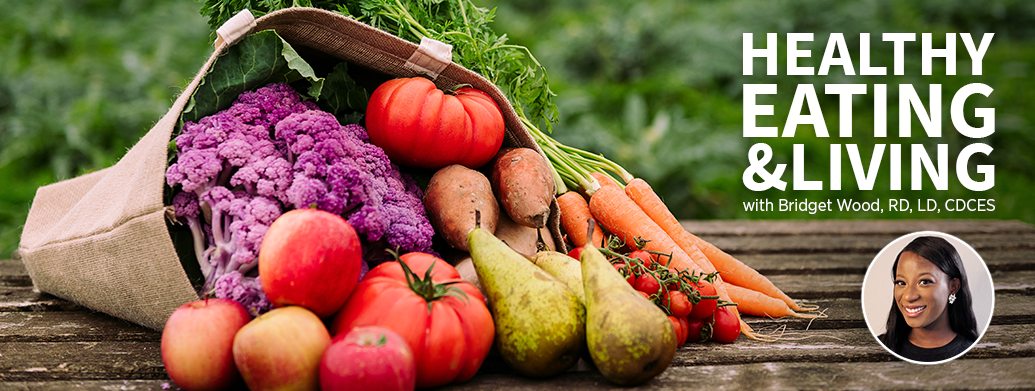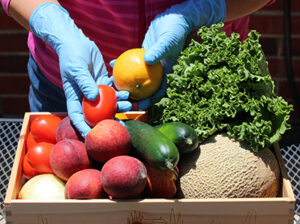
Hello and happy spring!
 I hope you’ve been working hard on those goals that we set at the beginning of the year! The great thing about goal setting is that they can always be adjusted and evaluated throughout the year!
I hope you’ve been working hard on those goals that we set at the beginning of the year! The great thing about goal setting is that they can always be adjusted and evaluated throughout the year!
Personally, March is one of my favorite months. It not only marks the beginning of spring and (hopefully) the transition to sunshine and warmer weather, but it is also National Nutrition Month! This year’s theme is “Fuel for the Future,” which not only encourages people to make informed food choices that support their long-term health and well-being, but it also encourages people to make sustainable food choices that support environmental health and reduce the impact of food production on the planet.
Simply put by the Harvard T.H. Chan School of Public Health, sustainability is when we “meet needs of the present without compromising the ability of future generations to meet their own needs.”
Making sustainable nutrition choices involves considering not only the nutritional value of the food you eat, but also the impact that the production, transportation and disposal of that food has on the environment. Believe it or not, you can actually tie in sustainable food choices with your diabetes management.
Let’s take a deeper look at some basic ways to do that and use your Glooko mobile app along the way!
CHOOSE PLANT-BASED FOODS
![]() Plant-based foods such as fruits, vegetables, whole grains and legumes have a smaller carbon footprint compared to animal-based foods. This is because plant-based foods require fewer resources to produce and transport. They also aid in managing blood sugar levels and overall health as they are typically good sources of fiber, vitamins, minerals and antioxidants. Plant-based diets can help improve glycemic control, reduce risks for heart disease, and even prevent Type 2 diabetes.
Plant-based foods such as fruits, vegetables, whole grains and legumes have a smaller carbon footprint compared to animal-based foods. This is because plant-based foods require fewer resources to produce and transport. They also aid in managing blood sugar levels and overall health as they are typically good sources of fiber, vitamins, minerals and antioxidants. Plant-based diets can help improve glycemic control, reduce risks for heart disease, and even prevent Type 2 diabetes.
Try tracking your plant consumption in the food tracker in the Glooko mobile app to help identify where you can adjust your intake of these beneficial foods.
EAT LOCAL AND SEASONAL FOODS
 Eating foods that are in season and locally grown can help reduce the carbon emissions associated with transportation. Additionally, local foods are often cheaper, fresher and may be more nutritious than foods that have traveled long distances.
Eating foods that are in season and locally grown can help reduce the carbon emissions associated with transportation. Additionally, local foods are often cheaper, fresher and may be more nutritious than foods that have traveled long distances.
Look for farmer’s markets or Community Supported Agriculture (CSA) programs in your area as they can be an affordable and fun way to try produce you haven’t tried before.
REDUCE FOOD WASTE
Food waste contributes to greenhouse gas emissions, so it’s important to minimize the amount of food that isn’t consumed. In fact, roughly one-third of all food produced globally is wasted.
By planning your meals ahead of time, storing food properly and using leftovers to make new meals—you can help do your part. Planning ahead can also lead to more stable blood glucose levels as you have time to address the best dosing strategy, assess any physical activity impacts, and have an overall better prediction of how blood sugars are going to react to the meals (although sometimes things react differently than we would expect, and that’s okay).
I’ll admit that despite my best efforts sometimes the vegetables and salad that I purchase don’t get the best attention. With rising food prices, throwing things away is not an option…not to mention it’s not good for sustainability!
REDUCE MEAT CONSUMPTION
Meat production has a high environmental impact, particularly when it comes to greenhouse gas emissions. You don’t have to go fully vegetarian or vegan, but reducing your meat consumption can help reduce your carbon footprint AND increase your time in range. By reducing your meat consumption and opting for more plant-based foods, you can increase your intake of complex carbohydrates, which promote blood sugar stabilization.
The high saturated fat found in meats can also increase your risk of heart disease when consumed in excess. Recent studies have also shown potential links to certain proteins in red meats may increase the risk of heart disease as well. According to the CDC, people with diabetes are twice as likely to have heart disease or a stroke than people without diabetes, so taking all of the steps to reduce consumption in the name of prevention is a win in my book!

And don’t forget that the Glooko mobile app is compatible with many leading smart blood pressure cuffs to monitor and track progress in lowering blood pressure over time.
By making sustainable nutrition choices, you promote better health and wellness for yourself and future generations. Try one (or all) of the steps above to “fuel your future” and check out more ways to do so from EatRight.
Need more inspiration? Check out my quick recipe for a Shakshuka Naan Pizza (PDF) using greens that were about to expire! This delicious naan pizza recipe uses those wilted greens that often find themselves in the trash and gives them a new life.
Your friend in food,
Bridget Wood, RD, LD, CDCES
MKT-0430 01

 Germany
Germany  Spain
Spain  France
France